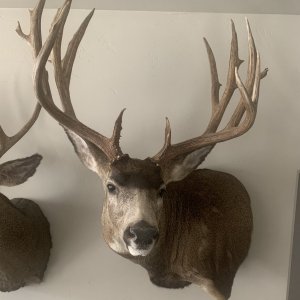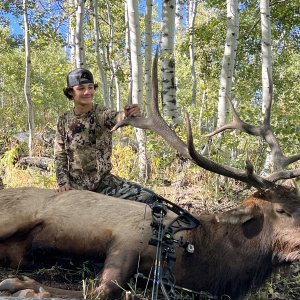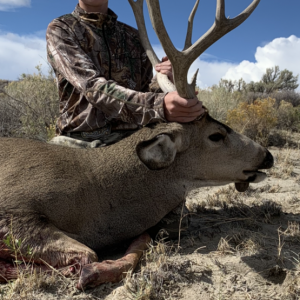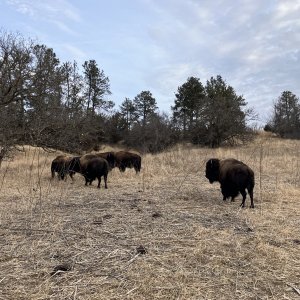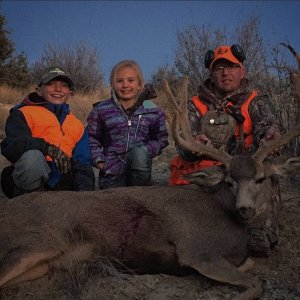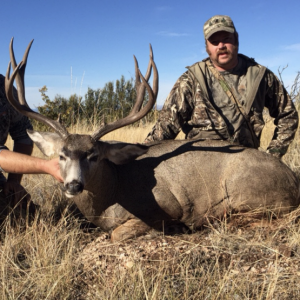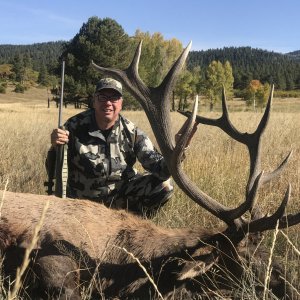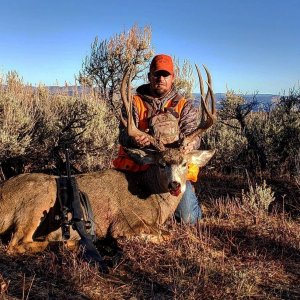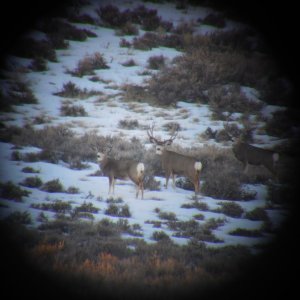Here is the RFP wording:
REQUEST FOR PROPOSALS
Host Annual Conservation Exposition and
Manage Allocation of Wildlife Expo Permit Series
Solicitation # AS16003
This Request for Proposals (?RFP?), having been determined to be the appropriate procurement method to provide the best value to the Conducting Procurement Unit, is designed to provide interested conservation organizations (?Offerors?) with sufficient basic information to submit proposals. It is not intended to limit a proposal's content or exclude any relevant or essential data. Offerors are at liberty and are encouraged to expand upon the specifications to evidence service capability. This RFP is issued in accordance with State of Utah Procurement Code and applicable Administrative Rules. Proposals submitted in response to this RFP satisfy the application requirement in Utah Admin. Code R657-55 and are referred to herein as ?Expo Applications.?
PART 1: OVERVIEW AND INSTRUCTIONS
1.1 PURPOSE OF REQUEST FOR PROPOSAL (RFP)
The purpose of this request for proposals is to select a conservation organization that, pending approval by the Utah Wildlife Board, will host an annual Wildlife Exposition and distribute the wildlife expo permit series. The Wildlife Expo and its associated wildlife expo permit series are generally described in Utah Admin. Code R657-55. The selected conservation organization, if approved by the Wildlife Board, will enter into a five year contract with the Utah Division of Wildlife Resources that will describe the terms and conditions of hosting an annual Wildlife Conservation Exposition.
1.2 BACKGROUND
The Division of Wildlife Resources (?UDWR?) has state statutory authority to manage and protect Utah's wildlife resources. UDWR?s mission is to serve the people of Utah as trustee and guardian of the state's wildlife. UDWR endeavors to recruit, retain, and if necessary reactivate hunters, anglers, and wildlife watchers from all walks of life. As part of this mission, the Wildlife Expo Program was established. The purpose of the program is to generate revenue to fund wildlife conservation activities in Utah, and to attract a regional or national wildlife exposition event to the State that is sponsored by one or more wildlife conservation organizations.
One component of the Wildlife Exposition Program is the administration of an annual hunting permit drawing. This drawing generally distributes up to 200 hunting permits to successful applicants. The conservation organization is responsible for administering the drawing. These permits are identified in Utah Admin. Code R657-55-3 as the ?Wildlife Expo Permit Series.?
A second component of the Wildlife Exposition Program is the Wildlife Exposition itself, generally referred to as the ?Expo.? The Expo is defined in Utah Admin. Code R657-55-2(c) as, ? ?a multi-day event held within the state of Utah that is sponsored by one or more wildlife conservation organizations as their national or regional convention or event that is open to the general public and designed to draw nationwide attendance of more than 10,000 individuals. The Wildlife Exposition may include wildlife conservation fund raising activities, outdoor exhibits, retail marketing of outdoor products and services, public awareness programs, and other similar activities." Together these elements are intended to attract sportsmen to help fulfill the UDWR mission.
1.3 ISSUING PROCUREMENT UNIT, CONDUCTING PROCUREMENT UNIT, AND RFP SOLICITATION NUMBER
For the purposes of this RFP the State of Utah Division of Purchasing is the Issuing Procurement Unit for this document and all subsequent addenda relating to it, on behalf of the Conducting Procurement Unit, Department of Natural Resources, Division of Wildlife Resources. The reference number for this RFP is Solicitation # AS16003. This number must be referred to on all proposals, correspondence, and documentation relating to this RFP.
1.4 QUESTION AND ANSWER PERIOD
All questions MUST be submitted through BIDSYNC (
www.bidsync.com) during the designated time for questions (?Q&A period?) listed on Bidsync. Questions submitted through any other channel will not be answered. Questions may be answered in the order that they are submitted or may be compiled into one document and answered via an addendum. Answers disseminated by the State through the BidSync system shall serve as the official and binding position of the State. Answers provided via BidSync will constitute an addendum to this RFP.
Notification to the State of any ambiguity, inconsistency, excessively restrictive requirements, and errors in this RFP, questions, or exceptions to the scope/content of the RFP MUST be submitted as a question through BidSync during the Q&A period.
Questions may be answered individually or may be compiled into one document. Questions may also be answered via addenda. An answered question or addenda may modify the specification or requirements of this RFP. Answered questions and addendums will be posted on BidSync. Offerors should periodically check BidSync for answered questions and addendums before the closing date. It is the responsibility of the Offerors to submit their proposal as required by this RFP, including any requirements contained in an answered question and/or addendums.
Exceptions to scope/content of the RFP that have not been previously addressed within the Q&A period of the procurement are not allowed and may result in the Offeror?s proposal being considered non-responsive.
1.5 ADDENDUMS
Offerors are encouraged to periodically check BidSync for posted questions, answers and addendums.
Any modification to this procurement will be made by addendum issued by the State Division of Purchasing. Addendums to this RFP may be made for the purpose of making changes to: the scope of work; the schedule; the qualification requirements; the criteria; the weighting; or other requirements of this RFP.
After the due date and time for submitting a proposal to this RFP, at the discretion of the chief procurement officer or head of a procurement unit with independent procurement authority, addenda to this RFP may be limited to the Offerors that have submitted proposals, provided the addenda does not make a substantial change to this RFP that, in the opinion of the chief procurement officer or head of a procurement unit with independent procurement authority likely would have impacted the number of Offerors responding to the original publication of this RFP.
Authorized and properly issued addenda shall constitute the official and binding position of the State.
Any response to this RFP which has as its basis any communications or information received from sources other than this RFP or related addenda could be considered non-responsive and be rejected at the sole discretion of the State.
1.6 RESTRICTIONS ON COMMUNICATIONS
Except as provided in Section 1.11, from the issue date of this RFP until an Offeror is selected and presented to the Wildlife Board for approval, Offerors are prohibited from communications regarding this RFP with the conducting procurement unit staff, evaluation committee members, or other associated individuals EXCEPT the State of Utah Division of Purchasing procurement officer overseeing this RFP. Failure to comply with this requirement may result in disqualification.
1.7 SUBMITTING YOUR PROPOSAL
By submitting a proposal to this RFP, the Offeror acknowledges and agrees that the requirements, scope of work, and the evaluation process outlined in this RFP are understood, fair, equitable, and are not unduly restrictive. Any exceptions to the content of this RFP must be addressed within the Q&A period. The Offeror further acknowledges that it has read this RFP, along with any attached or referenced documents, including the General Provisions.
Proposals must be received by the posted due date and time posted on Bidsync. Proposals received after the deadline will be late and ineligible for consideration.
Electronic submission instructions: When submitting a proposal electronically through BidSync, please allow sufficient time to complete the online forms and to upload proposal documents. The RFP will end at the deadline. If an Offeror is in the middle of uploading a proposal when the deadline arrives, the system will stop the upload process and the proposal will not be accepted by BidSync, and the attempted submission will be considered late and ineligible for consideration.
Electronic proposals may require uploading of electronic attachments. BidSync will accept a wide variety of document types as attachments. However, the State is unable to view certain documents. Therefore, DO NOT submit documents that are embedded (zip files), movies, wmp, encrypted, and mp3 files. All documents must be uploaded in BidSync as separate files.
Hard copy submission instructions: The preferred method of submitting your proposal is electronically through BidSync. However, proposals may be submitted in hard copy form, one (1) original and 5 (one for each member of the evaluation committee) copies of the technical proposal must be received prior to deadline at the following address:
State of Utah Division of Purchasing
3150 State Office Building, Capitol Hill
Salt Lake City, Utah 84114-1061.
The outside cover of the package containing the Technical Proposal shall be clearly marked ?Solicitation # AS16003 ? Technical Proposal? and include the deadline?. The outside cover of the Proposal shall be clearly marked ?Solicitation # AS16003 ? Proposal?, and include the closing time posted on Bidsync?. All proposals received by physical delivery will be date and time stamped by the State.
Please allow sufficient time for delivery of hardcopy proposals. Proposals sent overnight, but not received by the deadline time will not be accepted. When submitting a proposal by physical delivery (U.S. Mail, courier service, hand-delivery, or other physical means) Offerors are solely responsible for meeting the deadline. Delays caused by a delivery service or other physical means will not be considered as an acceptable reason for a proposal being late.
All costs incurred by an Offeror in the preparation and submission of a proposal including, any costs incurred during interviews, oral presentations, and/or product demonstrations are the responsibility of the Offeror and will not be reimbursed.
PROPOSALS MUST BE COMPLETE, THOROUGH, AND RESPONSIVE TO THE TOPICS DESCRIBED IN THIS RFP BY CLOSE OF THIS RFP SOLICITATION.
1.8 SELECTION OF CONSERVATION ORGANIZATION
It is anticipated that this RFP will identify a single conservation organization that will ultimately host the annual Conservation Exposition and manage the allocation of the Wildlife Expo Permit Series.
1.9 LENGTH OF CONTRACT
If the selected conservation organization is approved by the Wildlife Board, the conservation organization and UDWR will enter into a contract for a period of five (5) years. Per Utah Administrative Code R657-55-4(b), this contract may be extended for an additional period, not to exceed five additional years.
The State reserves the right to review any contract resulting from this RFP on a regular basis regarding performance and cost analysis and may negotiate modifications during the term of the contract.
1.10 PRICE GUARANTEE PERIOD
There is no pricing component for this RFP. This section is intentionally omitted.
1.11 DISCUSSIONS
Discussions may be conducted with the Offerors who submit proposals determined to be reasonably susceptible of being selected for award, followed by an opportunity to make best and final offers pursuant to Section 63G-6a-707.5 of the Utah Procurement Code, but proposals may be accepted without discussions.
1.12 STANDARD CONTRACT TERMS AND CONDITIONS, EXCEPTIONS, AND NEGOTIATIONS
Any contract resulting from this RFP will include, but not be limited to, the Standard Terms and Conditions for Services (?Standard Terms and Conditions?), a copy of which is included herein as Attachment A, and the Standard Information Technology Terms and Conditions, a copy of which is included herein as Attachment B. Upon approval of the recommended conservation organization by the Wildlife Board, UDWR and the selected conservation organization will negotiate a contract including the Standard Terms and Conditions as described herein, the proposal submitted by the conservation organization in response to this RFP, all components described in Utah Admin. Code R657-55, and other elements as agreed to by the Parties.
Exceptions and/or additions to the Standard Terms and Conditions are strongly discouraged. However, Offerors requesting exceptions and/or additions to the Standard Terms and Conditions must be submitted with the proposal. Exceptions and/or additions submitted after the date and time for receipt of proposals will not be considered. Offerors may not submit requests for exceptions and/or additions by reference to a vendor's website or URL. URLs provided with a proposal may result in that proposal being rejected as non-responsive. Offerors may submit questions during the Q&A period regarding the Standard Terms and Conditions.
The State may refuse to negotiate exceptions and/or additions that are determined to be excessive; that are inconsistent with similar contracts of the procurement unit; to warranties, insurance, indemnification provisions that are necessary to protect the procurement unit after consultation with the Attorney General's Office or other applicable legal counsel; where the solicitation specifically prohibits exceptions and/or additions; or that are not in the best interest of the procurement unit.
If negotiations are required, Offeror must provide all documents in Microsoft Word format for redline editing. Offeror must also provide the name, contact information, and access to the person(s) that will be directly involved in legal negotiations.
Any mandatorily required acceptance of an Offeror?s terms and conditions may result in the proposal being determined to be non-responsive.
An award resulting from this RFP is subject to successful contract terms and conditions negotiation (if required). The State, at its sole discretion, will determine when contract terms and conditions negotiations become unproductive and will result in termination of award to that Offeror and the State may move to the next eligible Offeror.
1.13 PROTECTED INFORMATION
The Government Records Access and Management Act (GRAMA), Utah Code Ann., Subsection 63G-2-305, provides in part that:
the following records are protected if properly classified by a government entity:
(1) trade secrets as defined in Section 13-24-2, the Utah Uniform Trade Secrets Act, if the person submitting the trade secret has provided the governmental entity with the information specified in Section 63G-2-309 (Business Confidentiality Claims);
(2) commercial information or non-individual financial information obtained from a person if:
(a) disclosure of the information could reasonably be expected to result in unfair competitive injury to the person submitting the information or would impair the ability of the governmental entity to obtain necessary information in the future;
(b) the person submitting the information has a greater interest in prohibiting access than the public in obtaining access; and
(c) the person submitting the information has provided the governmental entity with the information specified in Section 63G-2-309;
* * * * *
(6) records the disclosure of which would impair governmental procurement proceedings or give an unfair advantage to any person proposing to enter into a contract or agreement with a governmental entity, except that this Subsection (6) does not restrict the right of a person to see bids submitted to or by a governmental entity after bidding has closed; ....
Process for Requesting Non-Disclosure: Any Offeror requesting that a record be protected shall include with the proposal a Claim of Business Confidentiality. To protect information under a Claim of Business Confidentiality, the Offeror must complete the Claim of Business Confidentiality form with the following information:
1. Provide a written Claim of Business Confidentiality at the time the information (proposal) is provided to the state, and
2. Include a concise statement of reasons supporting the claim of business confidentiality (Subsection 63G-2-309(1)).
3. Submit an electronic ?redacted? (excluding protected information) copy of the proposal. Copy must clearly be marked ?Redacted Version.?
The Claim of Business Confidentiality form may be accessed at:
http://www.purchasing.utah.gov/contract/documents/confidentialityclaimform.doc
An entire proposal cannot be identified as ?PROTECTED?, ?CONFIDENTIAL? or ?PROPRIETARY? and shall be considered non-responsive unless the Offeror removes the designation.
Redacted Copy: If an Offeror submits a proposal that contains information claimed to be business confidential or protected information, the Offeror must submit two separate proposals: one redacted version for public release, with all protected business confidential information either blacked-out or removed, clearly marked as "Redacted Version"; and one non-redacted version for evaluation purposes clearly marked as "Protected Business Confidential."
1.14 INTERVIEWS AND PRESENTATIONS
If it is determined to be in the best interest of the Conducting Procurement Unit, interviews and presentations may be held at the option of the State. The State shall establish a date and time for the interviews or presentations and shall notify eligible Offerors of the procedures. Offerors invited to interviews or presentations shall be limited to those Offerors meeting the minimum requirements and minimum technical score threshold specified in the RFP. Representations made by an Offeror during interviews or presentations shall become an addendum to the Offeror's proposal and shall be documented. Representations must be consistent with the Offeror's original proposal and may only be used for purposes of clarifying or filling in gaps in the Offeror's proposal. Interviews and presentations will be at the Offeror's expense.
PART 2: SCOPE OF SERVICES AND REQUIREMENTS
2.1 DETAILED SCOPE OF WORK AND ADDITIONAL REQUIREMENTS
See Sections 2.2 and 2.3.
2.2 MANDATORY MINIMUM REQUIREMENTS/QUALIFICATIONS
This section contains mandatory minimum requirements that must be met in order for an offer to be considered responsive. Offerors shall include a detailed narrative outlining how their proposal meets the following minimum mandatory requirements. For ease of evaluation, an Offeror?s proposal must be a point-by-point response, addressing in detail each area of the mandatory minimum requirements and/or qualifications. All proposals must be consistent with Utah Admin. Code R657-55.
1. Offeror must be a qualified ?conservation organization,? defined in Utah Admin. Code R657-55-2(2)(a) as a ?nonprofit chartered institution, corporation, foundation, or association founded for the purpose of promoting wildlife conservation.?
2. Offeror must be capable of attracting a successful regional or national annual Wildlife Exposition to Utah, as defined in Utah Admin. Code R657-55-2(2)(c). This includes drawing nationwide attendance of 10,000 or more visitors. The wildlife exposition may include wildlife conservation fund raising activities, outdoor exhibits, retail marketing of outdoor products and services, public awareness programs, and other similar activities.
3. Offeror must be capable of administering the wildlife expo permit drawing or other random selection process in a way that fairly accomodates DWR?s constituents and is in accordance with state and federal law.
4. Offeror may not be in breach or default of any contractual agreement with the State of Utah at the time the Expo Application is submitted.
5. The Expo Application must include the name, address, and telephone number of the conservation organization, and the name of the president or other individual responsible for the administrative operations of the conservation organization.
6. The Expo Application must include a copy of the conservation organization?s mission statement.
7. Offeror must submit a detailed permit drawing procedures and data security plan (further described later in this document). This plan must include the following minimum protocols for conducting the expo permit drawing:
a. Drawing applicant data must be secured and the conservation organization must provide remedies or corrective action to applicants in the event of a data breach. Applicant data must be encrypted at rest and in transit. DWR must be notified of any data breach in accordance with Attachment B herein and state and federal law.
b. Offeror agrees to provide a report of a third party scan showing hardware and software vulnerabilities of any web application they plan to use to administer the expo permit drawing, or will allow the State of Utah to conduct a hospitable penetration scan of the web application internal to their network, prior to conducting the expo permit drawing.
c. Offeror may not share or market any personally identifying information Offeror collects from UDWR or permit applicants without the prior written consent of the permit applicant or their parent or legal guardian.
d. Offeror must allow applicants to apply for wildlife expo permits without purchasing admission to the wildlife exposition, and will ensure the Utah hunting license requirement is verified at the point of permit application.
e. Offeror must provide a mechansim for Utah hunting licenses to be sold to applicants at the expo without requiring applicants to purchase admission to the wildlife exposition.
f. Offeror must understand and comply with Payment Card Industry security standards (PCI Compliance) for all credit card transactions, and must agree to meet future PCI standards.
8. Offeror must obtain and maintain commercial general liability insurance consistent with the requirements of Paragraph 16 of Attachment A.
9. Upon approval by the Widllife Board, the selected applicant will be expected to hold an annual expo in Utah for the entire 5 year agreement. Offeror must demonstrate their capability to effectively plan and complete the wildlife exposition for this 5 year term.
10. Offeror must submit to an annual wildlife exposition audit by a division-appointed auditor.
Failure to meet any one of the mandatory requirements/qualifications will result in the proposal being rejected pursuant to Utah Code ?63 G-6a-704 and the proposal will not move forward in the evaluation process. After approval of the conservation organization by the Wildlife Board, other aspects of the proposal may be incorporated by reference into the contract between the successful applicant and UDWR as appropriate.
All of the items described in this section are non-negotiable. A rejection of a proposal due to a proposal not meeting mandatory minimum requirements can occur at any time in the evaluation process.
2.3 DETAILED TECHNICAL PROPOSAL RESPONSE REQUIREMENTS
All Offerors are to submit explanations that detail their experience and qualifications in the following areas (each area is to be addressed in the order listed):
1. Business Plan. For all descriptions and topics provided for this section, provide support and verification of your assertions and expectations, such as historical documentation of past performance, any market analysis or projections your organization may have performed, or other materials that may lend credibility to your business plan.
a. Expo operations. Discuss the past performance of your organization in planning and operating large scale events, conventions, and expositions, including activities undertaken in support of the conservation permit program described in Utah Admin. Code R657-41. Describe in detail how you will organize and run the expo. Provide an estimate of the number of attendees expected per year, the number of expo permit applications expected per year, the proposed location of the expo, proposed dates of the 2017 expo, and a detailed description of the proposed venue, including whether the venue is secured or if there is a reasonable expectation that the venue can be secured. List conservation and business organizations you expect to draw to the expo.
b. Economic considerations. Discuss your past performance in advertising and marketing large scale events, conventions, and expositions, including activities undertaken in support of the conservation permit program described in Utah Admin. Code R657-41. Describe your advertising and marketing strategy for the expo and how it will result in expanded attendance and participation by conservation organizations, vendors, and the public. Describe the projected economic benefits to the State of Utah stemming from the expo on an annual basis.
c. Promotion of hunting, fishing and trapping in Utah. Describe how your operation of the expo will benefit Utah sportsmen and women and wildlife conservation in Utah. Describe how your expo will result in recruitment, retention, and reactivation of Utah sportsmen and women of all ages. Describe how your operation of the expo will help further UDWR?s mission, including the square footage of floor space you would donate to UDWR, if any, for administration and outreach activities for items such as National Archery in the Schools Program (2 day state championship), Help Stop Poaching, Outreach, DWR Information, and general meeting space.
2. Permit Drawing Procedures and Data Security Plan. As background information, UDWR will make available to Offeror a procedure allowing the look-up of data on applicants that will facilitate the confirmation of their eligibility to apply for expo permits. If the Offeror chooses to sell hunting licenses through their own interface at the wildlife exposition, UDWR will provide a procedure allowing for the insert of a license record for an individual with whom the Offeror is conducting business. Describe in detail what coordination you will require from UDWR on these matters. Describe in detail how you will organize and conduct the permit draw, including expo permit application process, license requirement verification, draw process, in-person validation of expo permit applications, identification of successful applicants, creation of an alternate list, data retention, drawing venue, etc. Include a detailed description of data security and how you will protect applicant data from unauthorized release or data breach, and how you will respond to a breach. Include what data you will collect in order to perform the duties described in this RFP, what data you will retain following each expo permit drawing, and how you plan to use that data to market future wildlife expositions and wildlife conservation in Utah. Provide an explanation on how you will ensure that personally identifying data will not be sold or shared with other entities unless applicants specifically provide their written authorization to do so. Provide assurance that confidential data, such as social security numbers and driver?s license numbers, that may be used to interact with UDWR systems, will not be stored or retained on Offeror systems. Describe your understanding of applicant license requirements and explain how you will ensure compliance with the big game permit requirements identified in Utah Code 23-19-22. Demonstrate evidence of current PCI compliance for your organization and verify that all operations at the expo will comply with PCI standards.
3. Permit Application Fee Revenue. Revenue from permit application fees for expo permits is set at $5.00 per application. The contractor retains the entire $5.00, however must commit/spend $1.50 from each application fee collected on division-approved projects by September 1, two years following collection. Describe any proposed use of the remaining $3.50 to benefit protected wildlife in Utah. Estimate the total revenue from application fees that will be used to benefit protected wildlife in Utah, including any money provided directly to the State of Utah. Provide support and verification of your assertions and expectations, such as historical documentation of past performance, any market analysis or projections your organization may have performed, or other materials that may lend credibility to your estimates.
4. Historical Contributions/Past Performance. Describe in detail the historical contribution of your organization to wildlife in Utah, focusing on your conservation organization?s previous performance in wildlife conservation activities, as well as promotion and development of hunting, fishing, and trapping in Utah.
2.4 EVALUATION CRITERIA/TECHNICAL PROPOSAL
To determine which proposal provides the best value to the State, an evaluation committee will be established that includes representatives from various state agencies. The evaluation committee will evaluate each proposal that has not been disqualified or rejected using the criteria outlined on the RFP Evaluation Score sheet, included as Attachment C herein.
For ease of evaluation, the proposals must provide a point-by-point response, addressing in detail each area of the scope of work and the evaluation criteria, including addressing how the point-by-point response addresses the issues discussed in this RFP.
Evaluation Criteria. Admin. Code R657-55-1(2) identifies two main purposes of authorizing the distribution of the wildlife expo permit series: (1) attracting and supporting a regional or national wildlife exposition in Utah; and (2) generating revenue to fund wildlife conservation activities in Utah. These two purposes are reflected in the four evaluation criteria provided below:
1. Viability of Business Plan and potential to put on high quality wildlife exposition.
a. Expo operations. 20% of total score
b. Economic considerations. 10% of total score
c. Promotion of hunting, fishing, and trapping in Utah. 10% of total score
2. Ability to organize and conduct a secure and fair permit drawing. 20% of total score
3. Conservation organization?s commitment to use revenue generated through the wildlife expo for wildlife conservation in Utah, including the use of the remaining $3.50 of the Expo permit application fee. 30% of total score
4. Historical contribution and previous performance of organization in wildlife conservation in Utah. 10% of total score
PART 3: INFORMATION REQUIRED IN SUBMISSION OF A PROPOSAL
3.1 PROPOSAL FORMAT
Proposals should be concise, straightforward and prepared simply and economically. Expensive displays, bindings, or promotional materials are neither desired nor required. However, there is no intent in these instructions to limit a proposal?s content or to exclude any relevant or essential data.
All materials submitted become the property of the State. Materials may be evaluated by anyone designated by the state as part of the proposal evaluation committee. Materials submitted may be returned only at the State's option.
Organize proposal using each of the following specific headings. Failure to format your proposal as follows may result in disqualification.
1. Section Title: RFP Form. The State?s Request for Proposal form completed and signed by the Offeror.
2. Section Title: Executive Summary. The executive summary is to briefly describe the Offeror's proposal. This summary should highlight the major features of the proposal. The reader should be able to determine the essence of the proposal by reading the executive summary.
3. Section Title: Protected Information. All protected/proprietary information must be identified in this section of the proposal, by completing the Claim of Business Confidentiality referenced in Section 1.13.
If the Offeror?s proposal contains protected/proprietary information (refer back to the Protected Information section of this RFP for additional information) then Offeror must submit a redacted copy of the proposal at the same time Offeror submits its proposal. The redacted copy of the Offeror?s proposal must be submitted in compliance with other sections of this RFP.
If there is no protected information, indicate ?None? in this section.
Failure to comply with this Section and Section 1.13 of this RFP releases the State from any obligation or liability arising from the inadvertent release of Offeror information.
4. Section Title: Potential Conflicts of Interest. Offeror must identify any conflict, or potential conflict of interest, that might arise during the contract. If no conflicts are identified or expected, indicate ?None? in this section.
5. Section Title: Exceptions and/or Additions to the Standard Terms and Conditions. Proposed exceptions and/or additions to the Standard Terms and Conditions must be submitted in this section. Offeror must provide all proposed exceptions and/or additions, including an Offeror?s terms and conditions in Microsoft Word format for redline editing. Offeror must also provide the name, contact information, and access to the person(s) that will be directly involved in terms and conditions negotiations.
If there are no exceptions or additions to the Standard Terms and Conditions, indicate ?None? in this section.
6. Section Title: Mandatory Requirements.
Offeror must provide the required narratives that demonstrate compliance with the stated Mandatory Minimum Requirements/Qualifications. Offeror?s failure to meet any one of the mandatory requirements will result in the proposal being classified as non-responsive and will be rejected under the provisions of the Utah Procurement Code.
7. Section Title: Technical Requirements. This section describes the knowledge, skills, and abilities of a conservation organization regarding the Detailed Technical Requirements described in Section 2.3. Written narratives that are responsive to the categories provided in Section 2.3, as well as supporting documentation or citations, are to be included to provide support and credibility to the proposal.
3.2 ERRORS IN PROPOSALS
Pursuant to Utah Administrative Code R33-7-403, the following shall apply to the correction or withdrawal of an unintentionally erroneous proposal, or the cancellation of an award that is based on an unintentionally erroneous proposal. A decision to permit the correction or withdrawal of a proposal or the cancellation of an award or a contract shall be supported in a written document, signed by the chief procurement officer or head of a procurement unit with independent procurement authority.
(1) Mistakes attributed to an offeror's error in judgment may not be corrected.
(2) Unintentional errors not attributed to an offeror's error in judgment may be corrected if it is in the best interest of the procurement unit and correcting the error maintains the fair treatment of other offerors.
(a) Examples include:
(i) missing signatures,
(ii) missing acknowledgement of an addendum;
(iii) missing copies of professional licenses, bonds, insurance certificates, provided that copies are submitted by the deadline established by the chief procurement officer or head of a procurement unit with independent procurement authority to correct this mistake;
(iv) typographical errors;
(v) non-substantive mathematical errors; or
(vi) other errors deemed by the chief procurement officer or head of a procurement unit with independent procurement authority to be immaterial or inconsequential in nature.
(3) Unintentional errors discovered after the award of a contract may only be corrected if, after consultation with the chief procurement officer or head of a procurement unit with independent procurement authority and the attorney general's office or other applicable legal counsel, it is determined that the correction of the error does not violate the requirements of the Utah Procurement Code or these administrative rules.
PART 4: PROPOSAL EVALUATION
4.1 PROPOSAL EVALUATION
All proposals in response to this RFP will be evaluated in a manner consistent with the Utah Procurement Code, Administrative Rules, policies and the evaluation criteria in this RFP.
Offerors bear sole responsibility for the items included or not included within the proposal submitted by the Offeror. Each area of the evaluation criteria must be addressed in detail in the proposal.
4.2 Proposal Evaluation Process
Stage 1: Initial Review
In the initial phase of the evaluation process, the conducting procurement unit will review all proposals timely received. Non-responsive proposals not conforming to RFP requirements or unable to meet the minimum and/or mandatory requirements will be eliminated from further consideration.
Stage 2: Technical Proposal Evaluation
Responsive proposals will then be evaluated by an evaluation committee appointed by the conducting procurement unit against the proposal evaluation criteria noted in Attachment C. Attachment C establishes the minimum score threshold for this RFP.
Final Stage: Cost Proposal Evaluation
This is a no cost Request for Proposal.
4.3 Determination of Best Value
Subject to Section 63G-6a-709(2) of the Utah Procurement Code, in determining which proposal provides the best value to the Conducting Procurement Unit, the evaluation Committee and the Conducting Procurement Unit, pursuant to Section 63G-6a-708 of the Utah Procurement Code, shall prepare a written justification statement that: (i) explains the score assigned to each evaluation category; and (ii) explains that the proposal with the highest total combined score provides the best value to the Conducting Procurement Unit, or if a cost benefit analysis is required, the final determination based on the evaluation criteria.
PART 5: PROPOSAL AWARD PROCESS
After the completion of the proposal evaluation process and the justification statement, the evaluation committee shall submit the proposals, evaluation score summary sheet, and justification statement to the UDWR. The UDWR will then recommend the highest scoring conservation organization to the Wildlife Board for final approval.
5.1 AWARD OF CONTRACT
After the evaluation and final scoring of proposals is completed, UDWR will recommend the highest scoring acceptable proposal for approval by the Wildlife Board. All proposals, the evaluation score sheet summary, and justification statements will be provided to Wildlife Board representatives for their consideration as part of a public meeting. If approved by the Wildlife Board, the conservation organization and the UDWR will negotiate a contract for administration of the Wildlife Exposition and other responsibilities described in Utah Admin. Code R657-55 and this RFP.
All Offerors must make contact information of their conservation organization available to the Department of Workforce Services in accordance with Utah Code ?35A-2-203 . This requirement does not preclude the selected conservation organization from advertising job openings in other forums throughout the state.
5.2 PUBLICIZING AWARD
UDWR shall, on the next business day after the contract between UDWR and the selected conservation organization is executed, make available to each offeror and to the public a written statement that includes:
(a) the name of the selected conservation organization and the total score awarded by the evaluation committee to that Offeror;
(b) the total score awarded by the evaluation committee to each conservation organization not selected; and
(c) the proposals submitted in response to the RFP.

